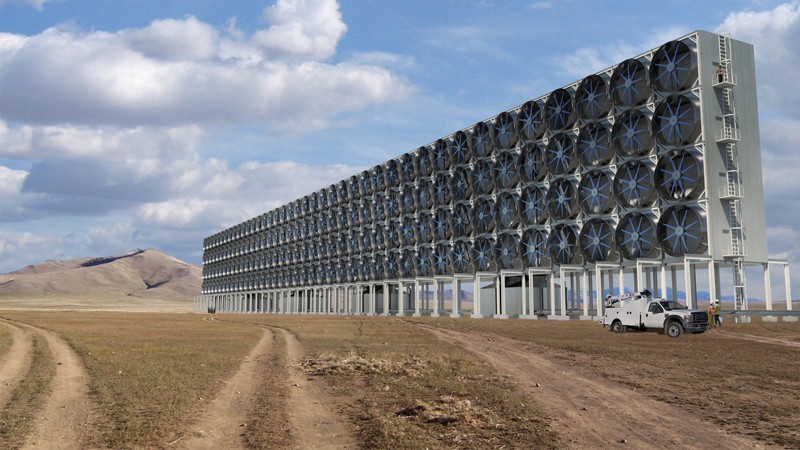General Discussion
Related: Editorials & Other Articles, Issue Forums, Alliance Forums, Region ForumsSucking carbon dioxide from air is cheaper than scientists thought
From https://www.nature.com/articles/d41586-018-05357-w
Estimated cost of geoengineering technology to fight climate change has plunged since a 2011 analysis.
Jeff Tollefson
PDF version

This artist’s rendering shows Carbon Engineering’s design for an ‘air contactor’ to pull carbon dioxide from the atmosphere.Credit: Carbon Engineering
Siphoning carbon dioxide (CO2) from the atmosphere could be more than an expensive last-ditch strategy for averting climate catastrophe. A detailed economic analysis published on 7 June suggests that the geoengineering technology is inching closer to commercial viability.
The study, in Joule, was written by researchers at Carbon Engineering in Calgary, Canada, which has been operating a pilot CO2-extraction plant in British Columbia since 2015. That plant — based on a concept called direct air capture — provided the basis for the economic analysis, which includes cost estimates from commercial vendors of all of the major components. Depending on a variety of design options and economic assumptions, the cost of pulling a tonne of CO2 from the atmosphere ranges between US$94 and $232. The last comprehensive analysis of the technology, conducted by the American Physical Society in 2011, estimated that it would cost $600 per tonne.
Carbon Engineering says that it published the paper to advance discussions about the cost and potential of the technology. “We’re really trying to commercialize direct air capture in a serious way, and to do that, you have to have everybody in the supply chain on board,” says David Keith, acting chief scientist at Carbon Engineering and a climate physicist at Harvard University in Cambridge, Massachusetts.
...
More at link.
roamer65
(36,744 posts)That is oxygen that we need to put back into the atmosphere.
ret5hd
(20,477 posts)First you want to get rid of the CO2, and NOW YOU WANT THE O2 BACK!!!
roamer65
(36,744 posts)Last edited Mon Dec 31, 2018, 08:45 PM - Edit history (1)
We need it for a little thing called respiration.
The majority of oxygen comes from the oceans and we are killing them.
Once we get to 19.5 percent O2 in the atmopshere, all hell will break loose...panic-wise.
1.45 percent to go...
jberryhill
(62,444 posts)It became CO2 in the first place because of oxidation of carbon fuel to obtain energy. If you want the O2 back, then you are going to need as much energy as was released in the first place by burning the fuel.
violetpastille
(1,483 posts)roamer65
(36,744 posts)They don’t produce enough oxygen to maintain human existence.
defacto7
(13,485 posts)In 2017 we put 32,100,000,000 tons of carbon into the atmosphere. Thirty two billion tons. Just round something off and do the math. It also has to be split and disposed of or reused. It's not so simple.
progree
(10,884 posts)of gasoline.
(Per a quick Google search)
From OP:
For anyone wondering, a tonne, also called a metric ton, is 1000 kg, equivalent to about 1.1 U.S. tons, (U.S. tons are also called short tons)
NickB79
(19,217 posts)$100/ton comes out to $3 trillion per year, every year, just to hold even, much less reduce atmospheric concentrations.
And as far as I can tell, the article doesn't consider costs to pump and store the CO2.
AND beyond that, most sequestration schemes use the gas to increase oil output from old oilfields, ironically increasing carbon emissions.
roamer65
(36,744 posts)Use solar, wind and hydro power to separate the hydrogen from H2O. You end up with a pure hydrocarbon fuel...no sulfur or any contamination. Pure clean burning gasoline...if you have atmospheric oxygen left to burn it.
Blue_true
(31,261 posts)Plant them on roadsides, city parks, forests, in Industrial parks as landscaping. They are very efficient when compared to trees.